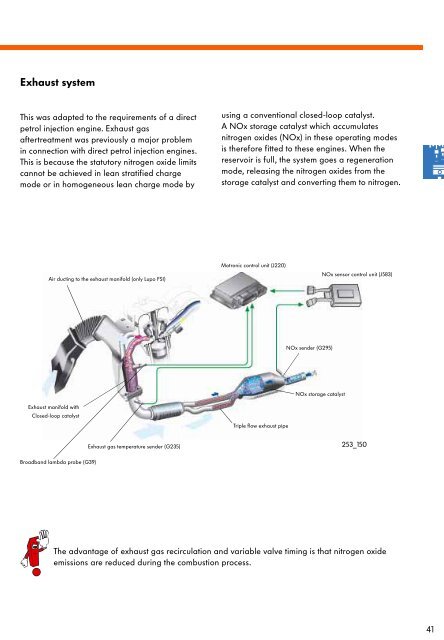Direct Petrol Injection System with Bosch Motronic MED 7 - Volkspage
Direct Petrol Injection System with Bosch Motronic MED 7 - Volkspage
Direct Petrol Injection System with Bosch Motronic MED 7 - Volkspage
Create successful ePaper yourself
Turn your PDF publications into a flip-book with our unique Google optimized e-Paper software.
Exhaust system<br />
This was adapted to the requirements of a direct<br />
petrol injection engine. Exhaust gas<br />
aftertreatment was previously a major problem<br />
in connection <strong>with</strong> direct petrol injection engines.<br />
This is because the statutory nitrogen oxide limits<br />
cannot be achieved in lean stratified charge<br />
mode or in homogeneous lean charge mode by<br />
using a conventional closed-loop catalyst.<br />
A NOx storage catalyst which accumulates<br />
nitrogen oxides (NOx) in these operating modes<br />
is therefore fitted to these engines. When the<br />
reservoir is full, the system goes a regeneration<br />
mode, releasing the nitrogen oxides from the<br />
storage catalyst and converting them to nitrogen.<br />
Air ducting to the exhaust manifold (only Lupo FSI)<br />
<strong>Motronic</strong> control unit (J220)<br />
NOx sensor control unit (J583)<br />
NOx sender (G295)<br />
NOx storage catalyst<br />
Exhaust manifold <strong>with</strong><br />
Closed-loop catalyst<br />
Triple flow exhaust pipe<br />
Exhaust gas temperature sender (G235)<br />
253_150<br />
Broadband lambda probe (G39)<br />
The advantage of exhaust gas recirculation and variable valve timing is that nitrogen oxide<br />
emissions are reduced during the combustion process.<br />
41

















